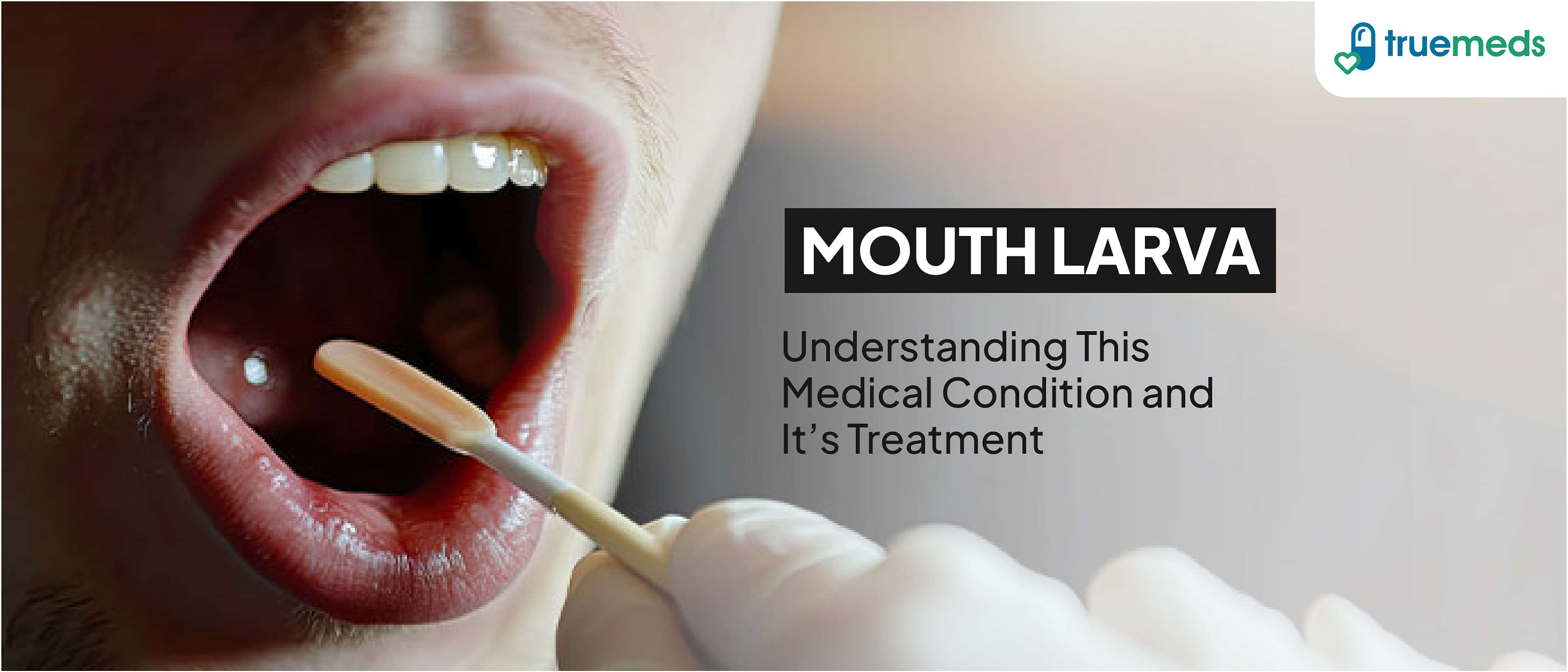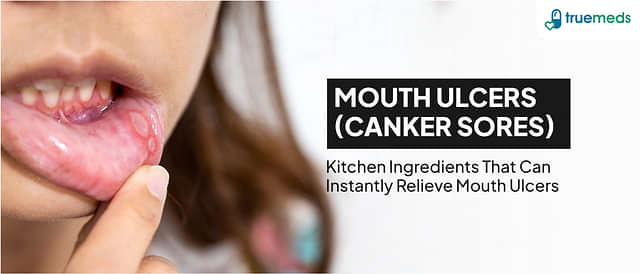Mouth Larva (Oral Myiasis): Types, Symptoms, Causes, Treatment & Prevention
Last updated on : 01 Dec, 2025
Read time : 11 min
Mouth larva, or oral myiasis, is an uncommon and rare medical condition characterised by the infestation of fly larvae (maggots) in the oral cavity [1]. While unusual, it can cause discomfort and tissue damage. Prompt treatment is crucial to prevent various complications.
Learn about the causes, symptoms, and treatments for mouth larvae, and how to manage and prevent them in this blog.
What is Oral Myiasis?
Mouth larvae are the parasitic pests that hatch and live within the oral cavities of human and animal hosts, causing an infection known as oral myiasis. While rare in humans, this condition is observed more frequently in individuals living in or travelling through tropical and subtropical regions [2].
Oral myiasis results from the presence of fly larvae in the mouth, commonly known as maggots. These larvae are typically introduced when flies lay their eggs on necrotic (dead) or diseased tissue, open wounds, or existing lesions within the oral cavity.
The larvae thrive by feeding on this tissue, and if left untreated, their activity can result in severe pain, swelling, and potential tissue destruction. The condition is more likely to affect individuals with poor oral hygiene, compromised immune systems, or existing oral wounds. Now that we understand what oral myiasis is, let’s discuss its types.
Did You Know?
Mouth larvae most commonly affect individuals in tropical and subtropical regions. While it can occur in any age group, children and older adults are sometimes noted to be at higher risk due to factors like pre-existing conditions, specific medications, or difficulties in maintaining adequate oral hygiene [2].
Certain species of flies, such as the New World screwworm fly (Cochliomyia hominivorax) and the Old World screwworm fly (Chrysomya bezziana), are the primary culprits behind oral myiasis in humans. Prompt diagnosis and treatment are crucial to prevent serious complications, as the larvae can rapidly destroy oral tissues and lead to disfigurement if left untreated.
Types of Oral Myiasis
Mouth larvae can be categorised based on the species of flies involved and the specific circumstances leading to the infestation. Here are some common types:
- Cochliomyia hominivorax: Known as the primary screwworm, this species is notorious for infesting living tissues, including the oral cavity. It is often associated with significant tissue damage and requires immediate medical attention.
- Chrysomya bezziana: This species is commonly found in tropical and subtropical regions and can also cause oral myiasis. It typically infests decaying tissues and can lead to severe complications if not treated promptly.
- Human Botfly (Dermatobia hominis): This species of fly lives in Southern and Central America and resembles bumblebees. The adults lay eggs that hatch into larvae on mammalian skin, mucosa (like the mouth), and other tissues [2].
Secondary Myiasis occurs when larvae infest necrotic or infected tissue, often exacerbating existing health issues. Addressing the underlying conditions is crucial to preventing this type of infestation.
Signs and Symptoms of Oral Myiasis
Recognising oral myiasis early is crucial for timely treatment and preventing complications. The condition can present with a range of signs and symptoms, which may vary in severity depending on the extent of the infestation.
Common Indicators Include:
- Swelling and Redness: Inflammation may appear in localised areas of the mouth or more broadly, depending on the severity.
- Discomfort or Pain: Individuals may experience mild to acute pain, especially while chewing, speaking, or moving the affected area.
- Lesions or Ulcers: Sores or ulcerations may form in the mouth, often providing an entry point for larvae and increasing the risk of secondary infections.
- Tissue Damage: As the larvae feed on oral tissues, visible destruction of affected areas may occur.
- Bleeding: Necrotic tissue or lesions may sometimes cause bleeding, signalling progression of tissue damage.
- Foul Odour (Bad Breath): The presence of larvae and decaying tissue can produce a noticeable foul odour.
- Sensation of Movement: Some patients report feeling movement or a foreign presence in the mouth due to larval activity.
Early recognition of these signs and symptoms can help individuals seek prompt medical attention, reducing the risk of severe tissue damage, infection, and other complications.
Causes of Oral Myiasis
Mouth larva infestation typically results from specific risk factors and underlying conditions. The primary causes include:
- Poor Oral Hygiene: Inadequate dental care can create an environment that attracts flies, as trapped food debris can serve as a breeding ground for them.
- Open Wounds or Existing Oral Lesions: Any injuries, sores, or lesions in the mouth can draw flies, leading to egg-laying and subsequent larval development.
- Compromised Immune System: Individuals with weakened immune systems are more susceptible to infections, including oral myiasis.
- Predisposing Lifestyle or Health Factors: Conditions such as severe alcoholism, mouth breathing during sleep, or psychiatric disorders can increase the risk of developing oral myiasis due to reduced awareness or difficulty in maintaining oral hygiene and mouth closure [3].
- Environmental Conditions: Infestations are more common in tropical and subtropical regions due to the favourable conditions for fly breeding.
Awareness of these causes can help prevent mouth larva infestation and encourage early intervention strategies, reducing the risk of further complications.
Risk & Complications of Oral Myiasis
Oral myiasis requires immediate medical attention. If left untreated, it can lead to serious complications. These include:
- Tissue Damage: The larvae feed on your oral tissues, causing significant destruction and necrosis. This can result in permanent damage.
- Secondary Infection: The presence of larvae can encourage bacterial growth, leading to secondary infections that may complicate your treatment.
- Tooth Loss: In severe cases of oral myiasis, teeth can be lost as the supporting structures become compromised.
- Systemic Infections: In rare instances, secondary bacterial infections can spread, potentially leading to conditions such as sepsis or blood poisoning, which can be life-threatening [4].
- Chronic Pain and Discomfort: A prolonged infestation could lead to ongoing pain and discomfort, affecting your quality of life.
These risks highlight the importance of early diagnosis and treatment of mouth larvae.
How to Prevent Oral Myiasis
Preventing oral myiasis is primarily about maintaining good oral hygiene and reducing risk factors. To protect against this condition, you should:
- Maintain Good Oral Hygiene Regular brushing and flossing can help eliminate food debris and bacteria that attract flies.
- Promptly Manage Oral Wounds Promptly treating open sores or mouth injuries can reduce the likelihood of fly infestations.
- Control Your Environment If you live in areas prone to fly infestations, use insect repellents and maintain cleanliness to minimise exposure, especially around food and open wounds.
- Monitor Overall Health If you have conditions that impair oral hygiene or mouth closure (e.g., due to disability or medical conditions), ensure that close monitoring and assistance with oral care is provided.
Following these preventive measures can significantly reduce your risk of developing oral myiasis.
How is Oral Myiasis Diagnosed?
Diagnosing mouth larvae involves a combination of a clinical examination and, often, a laboratory investigation of the extracted larvae. The diagnostic process typically includes:
- Clinical Examination A healthcare professional will thoroughly examine your oral cavity to identify signs of infestation, such as swelling, lesions, and the presence of larvae.
- Larval Extraction and Analysis In most cases, larvae are gently extracted from the mouth for identification. This is often done using specialised tools under sterile conditions. The extracted larvae will be examined under a microscope to confirm the species and assess the extent of the infestation.
- Medical History Review Your doctor may ask about your medical history, including any recent dental procedures, injuries, travel to endemic areas, or underlying health conditions that could increase your risk of oral myiasis.
How is Oral Myiasis Treated?
The treatment plan for oral myiasis must be managed by a healthcare professional and could involve a combination of various methods:
- Surgical Removal of Larvae A crucial step in treating mouth larvae is their mechanical or surgical removal. This procedure is typically performed under local anaesthesia to ensure patient comfort. During the procedure, the healthcare provider uses specialised tools, such as forceps or hemostats, to carefully extract the maggots one by one. This meticulous approach minimises tissue damage and helps prevent complications associated with the infestation.
- Debridement of Necrotic Tissue In conjunction with larval removal, thorough debridement of necrotic (dead) tissue is essential. This process involves cleaning the affected area to remove dead or infected tissue, which can harbour bacteria and exacerbate the condition. Proper debridement promotes healing and reduces the risk of further complications.
- Topical Applications In some cases, topical applications may be used to encourage the larvae to surface for easier removal. Substances such as mineral oil or petroleum jelly can be applied to the affected area. These agents can suffocate the larvae, prompting them to surface [2]. The use of mercuric chloride or turpentine oil should be strictly managed by a physician due to potential toxicity.
- Systemic Medications In addition to mechanical removal and topical treatments, systemic medications may be prescribed to support recovery. Antibiotics are often administered to prevent or treat secondary bacterial infections [4]. Antiparasitic medications like Ivermectin, sometimes used in combination with antibiotics like Clindamycin, have been documented in case studies to enhance the removal of maggots and support early recovery in specific clinical scenarios [5], [6].
In severe cases, additional surgery may be required to clean out dead tissue and promote healing. This step becomes particularly important in advanced stages of infestation to avoid complications like tissue damage, secondary infections or systemic spread of the infestation.
Key Takeaways
Let’s summarise what we’ve covered in our guide:
- Oral myiasis demands immediate medical attention for effective treatment.
- The primary steps in treatment are mechanical or surgical removal of larvae and debridement of necrotic tissue.
- Systemic medications, such as antibiotics to manage secondary infection, and antiparasitic drugs like Ivermectin, may be used as adjunctive therapy [5], [6].
- Maintaining proper oral hygiene and wound care is a must for preventing this medical condition.
With this knowledge, remember that early detection and timely treatment can save you from unwanted complications. If you observe any mouth larva symptoms, don’t delay consulting your doctor.
Expert Quote:
“Since oral myiasis is rare, it is easy to mistake this condition for another. If you are experiencing one or more signs of mouth larvae, it is important to get a consultation with your healthcare provider for an immediate and accurate evaluation. Delayed diagnosis in this case can lead to serious complications.”
– Dr. Sachin Singh
Frequently Asked Questions (FAQs)
Are mouth larvae dangerous?
Yes, mouth larvae can be harmful, leading to significant discomfort, tissue damage, and potential secondary infections if not addressed promptly.
How can I prevent mouth larvae?
Maintaining excellent oral hygiene, promptly treating any oral wounds, and being mindful of sanitation in fly-prone areas are the primary preventive measures.
Why do people get mouth larvae?
People commonly contract oral myiasis through flies laying eggs on existing open oral wounds, necrotic tissue, or in the mouths of individuals with compromised oral health or difficulty maintaining proper oral closure/hygiene [3]. The claim about consumption of contaminated food or water is less common for oral myiasis and has been removed for accuracy.
Can mouth larvae be cured?
Absolutely. Proper treatment, which typically involves the removal of the larvae by a doctor and the use of supporting medications, leads to a cure. Maintaining stringent oral hygiene afterwards is crucial for preventing recurrence.
References
[1] Saravanan, T., Mohan, M., Thinakaran, M., & Ahammed, S. (2015). Oral myiasis. Indian Journal of Palliative Care, 21(1), 92. https://doi.org/10.4103/0973-1075.150200
[2] Aggarwal, A., Daniel, M. J., Shetty, R. S., Kumar, B. N., Sumalatha, C. H., Srikanth, E., Rai, S., & Malik, R. (2014). Oral Myiasis Caused by Chrysomya bezziana in Anterior Maxilla. Case Reports in Dentistry, 2014, 1–4. https://doi.org/10.1155/2014/518427
[3] Verma, S. B., Sharma, H. L., Rathi, S. K., & Sharma, V. K. (2011). Oral Myiasis: A Case Report and Review of the Literature. Journal of Clinical and Diagnostic Research: JCDR, 5(2), 405–408. https://www.jcdr.net/article_fulltext.asp?issn=0973-709X&year=2011&volume=5&issue=2&page=405&issn=0973-709X&id=929
[4] Alipour, H., Shahsavari, S., & Ghomi, E. (2019). Oral Myiasis: A Literature Review. Journal of Research in Medical Sciences: The Official Journal of Isfahan University of Medical Sciences, 24(1), 74. https://doi.org/10.4103/jrms.JRMS_186_19
[5] Patel, B., Ostwal, S., Sanghavi, P. R., Joshi, G. S., & Singh, R. (2018). Management of malignant wound myiasis with ivermectin, albendazole, and clindamycin (triple therapy) in advanced head-and-neck cancer patients: A prospective observational study. Indian Journal of Palliative Care, 24(4), 459–459. https://doi.org/10.4103/ijpc.ijpc_112_18
[6] Kumaran, K. V., Sahoo, N. K., & Prabu, D. (2016). Oral Myiasis: A Case Report. Journal of Clinical and Diagnostic Research: JCDR, 10(10), ZD31–ZD32. https://doi.org/10.7860/JCDR/2016/22026.8770
Disclaimer
Our healthcare experts have carefully reviewed and compiled the information presented here to ensure accuracy and trustworthiness. It is important to note that this information serves as a general overview of the topic and is for informational purposes only. It is not intended to diagnose, prevent, or cure any health problem. This page does not establish a doctor-patient relationship, nor does it replace the advice or consultation of a registered medical practitioner. We recommend seeking guidance from your registered medical practitioner for any questions or concerns regarding your medical condition.
Popular Articles
Recommended Articles
Recent Articles
Company
About UsHealth ArticleHealth StoriesHealth LibraryDiseases & Health ConditionsAyurvedaUnderstanding Generic MedicinesAll MedicinesAll BrandsNeed HelpFAQSecuritySubscribe
Registered Office Address
Grievance Officer
Download Truemeds
Contact Us
Our customer representative team is available 7 days a week from 9 am - 9 pm.
v4.10.2
2025 - Truemeds | All rights reserved. Our content is for informational purposes only. See additional information.
Our Payment Partners













































